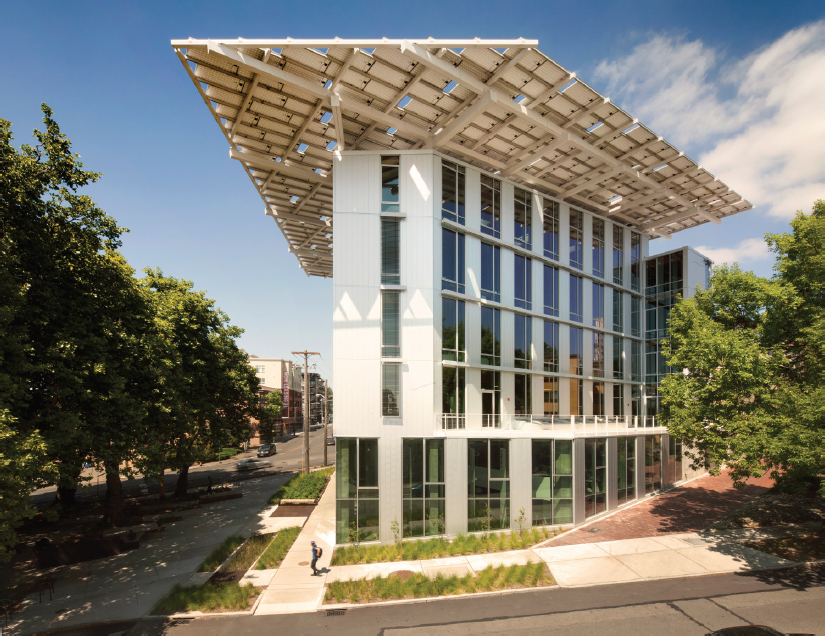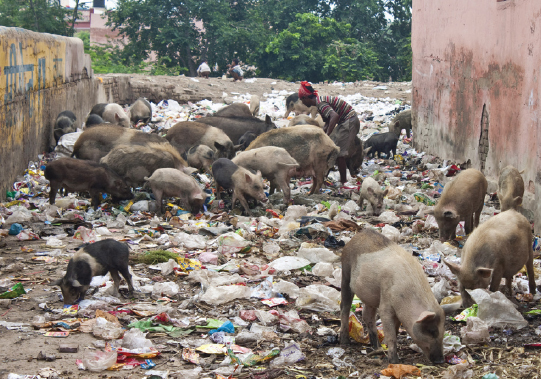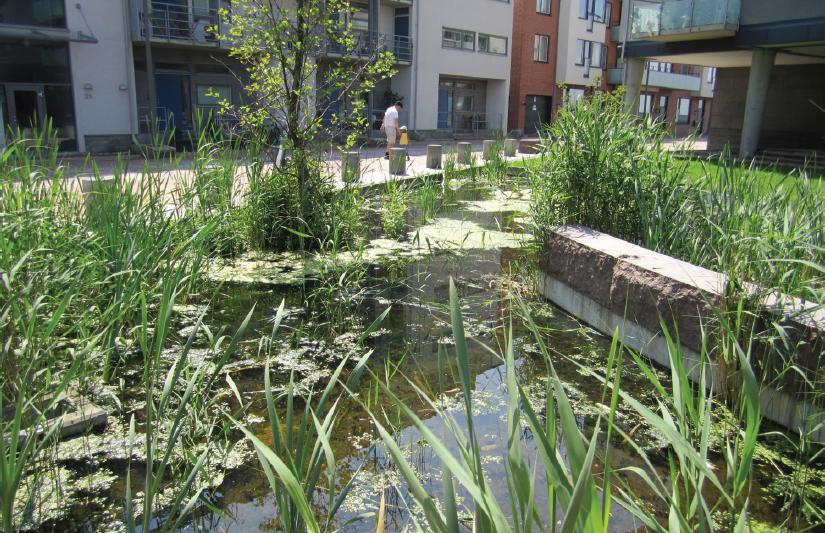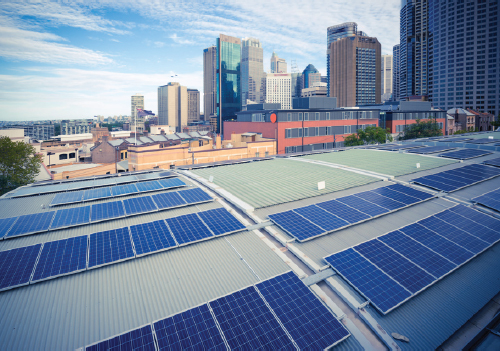
GRAND CHALLENGE 4:
Create Efficient, Healthy, Resilient Cities
The future is increasingly urban. Cities will absorb almost all of the world’s projected population growth in the next three decades. By 2050 cities will be home to over 2 billion more people than today. The proportion of the world’s population that lives in urban areas will grow from 55 percent in 2017 to 66 percent in 2050.214 By 2030, 10 more cities are expected to cross the 10-million-inhabitant threshold for the first time, increasing the number of “megacities” from 31 in 2016 to 41 in 2030. The majority of these will be in lower-income countries and contain large slums—dense informal developments without government services.215
While this massive concentrated population growth is likely to further compound many of the current problems that cities face, the urbanization of the human population is happening at least in part because of the inherent attractiveness of cities. They offer significant educational, economic, and cultural opportunities as well as better access to communication and health care services. These opportunities draw migrants from the rural countryside where such opportunities are sparser. As noted in a 2016 United Nations report on urbanization, cities are seen as economic hubs and drivers of innovation and competition, propelling a steady flow of people from rural to urban areas, particularly in Asia.216

Even as this economic attraction accelerates urbanization, today’s cities face persistent problems associated with air and water pollution, energy distribution, water supply, waste disposal, and waste generation. Although cities only occupy 3 percent of Earth’s ice-free landmass, they produce 50 percent of global waste and 60 to 80 percent of global greenhouse gas emissions. Cities account for 60 to 80 percent of the world’s energy use and 75 percent of all natural resource use.217
Cities have stark inequities in the distribution of incomes, public services, access to open space, and quality of life. In middle- to high-income countries, urban sprawl and car-centric and inefficient transit systems create traffic congestion, pollution, and safety hazards, degrading quality of life. Lack of green space and abandoned properties contribute to social and environmental stress, especially in poor urban neighborhoods. Urban communities are fractured by poverty and unequal access to community services, even as accelerating gentrification exacerbates those inequities.
In low- and middle-income countries, large populations live in dense informal settlements that are expanding rapidly; about 880 million people live in slums today and that number is projected to more than double by 2050.218 With many cities unable to provide adequate sanitation or food and water security for these slums, their residents face a high risk of malnutrition and disease.219 Increased human contact with domestic animals and wildlife in these settings heightens the risk of diseases with pandemic potential that emerge from animals and subsequently spread from person to person, as occurred with the SARS epidemic. SARS spread rapidly to more than 30 counties before being contained.220
The functioning and stability of many of the world’s major cities are made all the more precarious by threats from extreme events such as floods, heat waves, and droughts, which are expected to hit cities harder and more frequently in the coming decades, putting more lives and infrastructure at risk.221

These challenges, however, are not insurmountable. The scale and structure of cities offer unique opportunities to improve quality of life and equitably address many of the grand challenges such as climate change adaptation, pollution, waste, and sustainable food, water, and energy supplies. Aging physical infrastructure represents both a major challenge and a key opportunity to reshape tomorrow’s world. The American Society of Civil Engineers has estimated that $4.6 trillion in U.S. infrastructure investment will be needed by 2025,222 and the Organisation for Economic Co-operation and Development estimates worldwide infrastructure needs at $70 trillion by 2030.223 If this infrastructure were refashioned to support multiple city functions and the lives of residents in an integrated way, it is possible to create cities that are more equitable, efficient, healthy, and resilient. Environmental engineers can bring unique training and analytical skills to build partnerships with the other professions—in planning, energy, and transportation, among others—who together can creatively overcome these challenges and take advantage of the significant opportunities that cities present.
What Does an Efficient City Look Like?
Cities can be viewed as urban ecosystems, composed of systems of infrastructure networks (such as water, energy, transportation, waste, and public spaces), the people who use and operate the infrastructure, and the multiple interactions that occur between them. Accordingly, urban infrastructure is a system of systems through which energy, money, information, and materials flow. Significant inequity in the distribution of resources and political power within cities can result in infrastructure systems that serve different communities to different degrees.
There are multiple ways to make cities more efficient, both by increasing the efficiency of their individual parts and by making various systems function more in concert with each other. For example, waste from one system can be used in another system (waste to market or waste to energy), thereby minimizing inputs and reducing net waste (see also Challenge 3). Documenting inequities in the distribution of infrastructure services can help urban planners and engineers work to address those issues. Two approaches to improve a city’s efficiency involve reenvisioning urban infrastructure and incorporating smart systems.
Reenvisioning Urban Infrastructure
Cities cannot achieve these desired efficiencies by simply monitoring and improving the operations of older infrastructure. In the past, infrastructure systems were designed to optimize water delivery, energy provision, transit, and land use in a siloed fashion that led to suboptimal solutions. Going forward, sustainable urban infrastructure development needs to look beyond the local scale and consider transboundary infrastructures across regional, national, and global scales.224 For example, developing reliable, nutritious, and sustainable food supplies in densely populated cities requires looking beyond a city’s boundaries to the full range of producers, suppliers, and transporters and the implications to energy and water use and greenhouse gas emissions.

Cities can be more efficient by considering the urban infrastructure as a system of systems at many scales rather than individual disconnected entities (energy, water, sanitation, and traffic). The design of buildings and communities affects how much energy and water are used and how much waste is produced (Figure 4-1). Low-impact development that mimics natural processes, for example rain gardens and porous pavement, reduces uncontrolled stormwater runoff and its associated water pollution and erosion.225 It also provides additional benefits such as added urban green space, reduced urban heat island effects, and recreation opportunities. Improved management of urban stormwater runoff increases nutrient and organic matter concentrations in wastewater, making it easier to recover valuable resources, such as energy and nutrients. Urban aquaponic systems, in which fish and plants are grown together, can recycle wastes and nutrients while providing food security and eliminating food deserts.
Integrated urban solutions that address multiple needs or challenges can also help save money. For example, in lieu of filtration to maintain water quality control

of pathogens, for about 90 percent of its supply New York City uses watershed protection strategies combined with chlorination and ultraviolet disinfection. This approach up to the present time has allowed the city to save $8 billion to $10 billion in capital expenses and approximately $1 million per day in operational costs as compared to an engineered filtration-based approach for the entire supply.226
There are significant opportunities to transform urban infrastructure, but also large challenges: Most of the residential and commercial buildings and other infrastructure in today’s cities are old and inefficient, needing significant investment to be maintained let alone enhanced. Older infrastructure is especially prevalent in the poorest urban communities, further exacerbating inequities. This transformation to efficient, sustainable urban infrastructure—and the contributions of environmental engineers to that transformation—will need to address head-on how to apply those changes not just to new buildings and infrastructure, but to adaptive reuse and revitalization in all city neighborhoods.
Advancing Smart Cities
Improvements in efficiency can also be gained through “smart” technologies that capitalize on advances in sensing technology, data, connectivity, artificial intelligence, and participatory governance to optimize operations and resource management.227 A smart system can be not only reactive but proactive, using inputs, information processing, intelligence, and actuation to anticipate and prevent
problems or inefficiencies.228 Although there are many ways to define a “smart city,” the basic idea is that cities can improve outcomes, such as efficiency or quality of life, by incorporating smart interconnected systems into municipal functions.229
Technological advancements are increasing opportunities to develop smarter cities. Improvements in sensing technology have made it feasible to collect detailed geospatial and other types of data on the systems that keep cities ticking, such as transportation patterns and water and energy use. When appropriately analyzed and connected to decision making or operational controls, these data can be a powerful asset to improve city functions and planning. Developments in data science and machine learning are advancing these capabilities; a 2018 report by the World Economic Forum230 identified artificial intelligence as a key technology for efforts to transform traditional sectors and systems to address climate change, deliver food and water, protect biodiversity, and bolster human well-being.
Smart systems are being tested in cities around the world. To date, most of these tests focus on isolated sectors, such as transportation, emergency response, or electricity distribution (see Box 4-1), although some projects are experimenting with combining multiple smart systems across a community (see Sidebar).
Despite these encouraging developments, adaptive, full-scale predictive smart cities are still a long way off. Questions around performance, control, security, economics, equity, and ethics in smart cities must be addressed in order to fully realize the complete suite of societal benefits.241 In addition, while sensors and
tools for citizen participation are being actively developed, implementation—effectively integrating real-time information and feedback into actual city operations—remains a challenge.242 These challenges are not mere technological hurdles; overcoming them will require deep understanding of the physical and social systems that are integral to city functions, as well as a deeper understanding, on the part of engineers and city managers, of the opportunities and limitations of the technology. Furthermore, there is a need not only to continue to develop and scale tools for collecting data, but also to facilitate the effective and equitable application of such information. This will require interdisciplinary efforts to manage and interpret data, a willingness and capacity to adapt city operations to changing circumstances, and adequate protections for privacy and security.
What Makes a City Healthy?
Healthy cities facilitate good health and promote a high quality of life for all their residents. Healthy cities support mental and physical health, providing residents sufficient and equitable access to community services, education, housing, art, clean rivers, recreation, and green space, as well as protection from crime, violence, and hazardous environments. Clean air, safe drinking water and sanitation, effective and affordable transportation, reliable access to power, ample opportunities for employment, and access to nutritious food and health services are important facets of a healthy city.
Healthy buildings are a critical component of healthy cities because people spend over 90 percent of their time indoors.243 Healthy buildings are constructed of materials that do not off-gas toxic compounds into the air. They feature ventilation and lighting designed to optimize productivity and well-being, while also conserving energy. Designing buildings for health, well-being, and water and energy conservation can sometimes involve trade-offs to optimize for competing needs. For example, a tightly sealed building is more energy efficient with respect to temperature control, but it also allows build-up of contaminants in air. Likewise, technologies and practices designed to save water and reduce energy used for heating water may inadvertently promote the spread of pathogenic microbes.244


The capacity to prevent, detect, and mitigate the spread of infectious disease is particularly vital to healthy cities, but it will become more difficult to establish and maintain this capacity as cities and slums grow larger and denser. Many emerging diseases result from transmission of infectious agents from animals to people.245 These trends underscore the need to take a holistic view of public health that encompasses the health of humans, animals, and the environment, a concept and approach known as One Health.246 Two important infectious disease challenges are the emergence of diseases with pandemic potential and the emergence of antibiotic-resistant pathogens.247 Although these challenges are not uniquely urban, many infectious disease problems could be exacerbated in cities and spread through connected suburban communities.
Sophisticated techniques such as culture-independent diagnostics, genomic analysis, and advanced epidemic modeling offer valuable tools to track and contain the spread of pathogens and antibiotic-resistant organisms. Yet, these tools cannot make up for a lack of basic infrastructure to deliver clean air, safe food and water, sanitation services, and reliable electricity to homes and health care facilities. The knowledge and technology to mitigate many of the environmental drivers of infectious disease and other public health threats exist, but there are significant gaps in infrastructure and services, especially in the poorest areas. This disparity points to a need for more efficient, scalable solutions to support public health, including measures to prevent and contain infectious diseases along with improvements to the broader social and physical environments of the world’s cities.
Innovative solutions have been proposed to apply technologies and policies to improve public health in low-income settings. In Africa’s largest urban slum (Kibera in Nairobi, Kenya), integrated “biocenters” are being used to capture waste and digest it into biogas, which can be used as cooking fuel, thereby helping to manage waste while simultaneously reducing exposures to both outdoor and indoor air pollution from traditional cooking with wood, dung, and charcoal.248 The Diesel Emissions Reduction Act249 has provided grant funding and other incentives to support clean diesel projects, helping to replace old diesel school buses in low-income communities in Houston with low-emission models, reducing children’s exposure to pollution from diesel exhaust. With new emission standards and advances in technology, the percentage of low-income populations in the United States that live with air quality above the current fine-particulate standards dropped from 57 percent in 2006-2008 to 8 percent in 2014-2016.250
What Makes a City Resilient?
Resilient cities have the capacity to endure disasters, whether they are economic, environmental (such as floods, earthquakes, or drought), or the result of terrorism. To be resilient, cities must have the ability to withstand stress and quickly recover or adapt. One way to accommodate stress is to have redundant systems, for example, in utilities such as power or water grids or transportation routes, to
support continued operations when the primary system is not functional. Resilience also means being able to mobilize resources quickly in response to a disruptive event and contain the amount of damage caused. Resilience encompasses preparation, response, recovery, and adaptation.
Increasing a community’s resilience can involve repurposing existing systems or creating infrastructure that serves multiple purposes. Boston’s Muddy River Restoration Project restores riparian habitat to reduce the severity of flooding events.251 The project discourages development in flood-prone areas, reducing the damage, displacement, and disruption associated with future floods. In the wake of significant flooding, Copenhagen’s Østerbro neighborhood is creating a network of green streets and neighborhood park stormwater retention areas that will make the neighborhood more resilient to future storms.252
To increase resilience, it is important to systematically assess current vulnerabilities to inform better design. Such assessments can be used to prioritize measures for addressing vulnerabilities through existing and planned systems and infrastructure. Climate science provides one input into such an assessment. For example, planners can use decision tools to examine the range of potential infrastructure impacts associated with future climate scenarios, projecting threats such as sea-level rise, drought, and extreme heat. Planners also need to look at anticipated shifts or stressors that are likely to affect a city’s ability to respond to such events. For example, it may be important to assess transportation patterns and factors that may influence the number and use of vehicles. As a city’s population rises, dramatic increases in the number of vehicles could overwhelm infrastructure and necessitate the replacement of open lands with parking areas and buildings that would exacerbate flooding and increase heat island effects. On the other hand, a significant increase in the use of shared vehicles, as might occur with autonomous vehicles, could eliminate 90 percent of parking demand,253 thereby reducing projected flood risk and allowing the repurposing of parking space for the creation of green space.
Many cities are actively pursuing sustainable, multipurpose solutions like those in Copenhagen and Boston, but the scale of these projects is often not aligned


with the full scale of the challenge, and there remains much room for improvement toward understanding risks and building more resilient structures, systems, and communities. In addition to research and technological solutions, becoming resilient requires a cultural shift among decision makers, stakeholders, and citizens. By better assessing, understanding, and communicating risk, cities can garner support for forward-looking resilience goals and the steps needed to achieve them.
What Can Environmental Engineers Do?
In general, efficient, healthy, resilient cities will not be built from scratch. Rather, the challenge is to incorporate new designs and systems into existing cities and their infrastructure. This means actively reengineering existing land-use patterns, built environments, and water, sewer, electricity, and transportation modalities and infrastructure. What’s more, cities must undertake these efforts at the same time as they are absorbing massive population growth, that stresses current systems as new ones are established. This will undoubtedly be a complex process, and implementing effective solutions will require research and coordination involving multiple disciplines and sectors. Research is needed to identify and prioritize key vulnerabilities that cities face and effective adaptations that they should undertake. These efforts should include gleaning lessons from cities that have begun such transitions, as well as finding innovative ways to engage both the private sector, which has significant sway over the state of the built environment, and the public sector, which typically leads the way on infrastructure.254
Creating efficient, healthy, resilient cities involves many overlapping considerations from the challenges discussed previously in this report. The solutions will require leadership, systems thinking, and innovation from environmental engineers working with the many other professionals—in planning, transportation, energy, and public health, among others—to create and implement successful urban solutions. In particular, the tools of environmental engineering will be invaluable in applying sensors strategically, building distributed systems, and improving the design of cities.
Applying Sensors Strategically
Sensors are key to smart, responsive cities and are particularly valuable for conserving resources and increasing livability and safety. Traffic-monitoring sensors, for example, can be used to change signal patterns to relieve congestion in real time or inform long-term solutions to more systemic traffic issues, thus reducing the amount of energy wasted, pollution generated, and productivity lost in traffic jams. Similarly, sensors that collect data on water or energy use can help individuals minimize their consumption of these resources and inform how utility companies manage and deliver them or respond to disruptions. Systems that monitor chemical or biological contaminants in air, water, food, and human populations can provide early warning of emerging health threats. Sensor technology is developing rapidly and in many cases is now good enough and cheap enough for widespread use;
the question is, how can these technologies be deployed and utilized through applications of artificial intelligence algorithms to enable efficient operations at the scale of a city?
Building Distributed Systems
Although many of today’s cities are built with centralized systems for water, energy, and waste, distributed systems could make cities both more efficient and more resilient. For example, buildings or city blocks can generate their own electricity by incorporating renewable sources such as solar, wind, biomass, or wastewater. Or, they can reduce their reliance on centralized water supplies by collecting graywater, rainwater, or cooling water and using it for nonpotable purposes.255 Multimodal systems, such as combined cooling, heating, and power systems, use the waste heat from electricity generation to heat or cool buildings; these systems can be twice as efficient as separate systems256 and also reduce greenhouse gas emissions, air pollutants, and water consumption.257 A city with a combination of centralized and distributed systems also means that, in a time of disaster, people live closer to the services they need and are less heavily impacted by disruptions that occur elsewhere in the city. These same distributed systems could also be customized for use in rural areas, providing access to services that are costly to deploy in areas with low population density.
Although there are now many emerging technologies and models to support distributed systems, environmental engineering expertise is needed to determine which solutions are most practical, resource efficient, and appropriate for different circumstances and to optimally integrate these solutions into existing city infrastructure. At the same time, it is important to continue to develop, optimize, and apply distributed solutions to address the anticipated demands and needs of future cities. To ensure that these solutions are practical and palatable for communities, environmental engineers will also need to be trained to look beyond the technology opportunities and understand perceived and real unintended impacts, such as noise and emissions, which have stymied previous efforts to distribute energy generation in cities.
Improving City Design
Revising the design of cities will be necessary to accommodate more people in a way that improves rather than harms quality of life. Connectivity is one important element. Connecting people from all economic strata to basic goods and services—from clean water and reliable electricity to groceries and health care to employment—improves equity, health, and resilience. Improving infrastructure for active transportation (walking and cycling) can enhance health and reduce congestion, energy use, and pollution. Optimizing the design of buildings and public spaces—and identifying ways to build those principles into the revitalization of existing buildings and public spaces—is another key goal that can reduce resource consumption and improve environmental quality and quality of life.


Adapting to climate-related changes and designing for resilience will be key to sustaining cities and their populations in the coming decades. Such adaptations often can serve multiple purposes; for example, equitably distributed green space can promote well-being,258 while also mitigating natural disasters by absorbing floodwaters and recharging aquifers. Stakeholder engagement is paramount to ensure citizen support for new city designs (see Challenge 5). By identifying, prioritizing, and implementing solutions that will reap multiple benefits, environmental engineers can make significant contributions toward building more efficient, healthier, and more resilient cities. Box 4-3 provides specific examples of ways that environmental engineers can work to create efficient, healthy, resilient cities.












